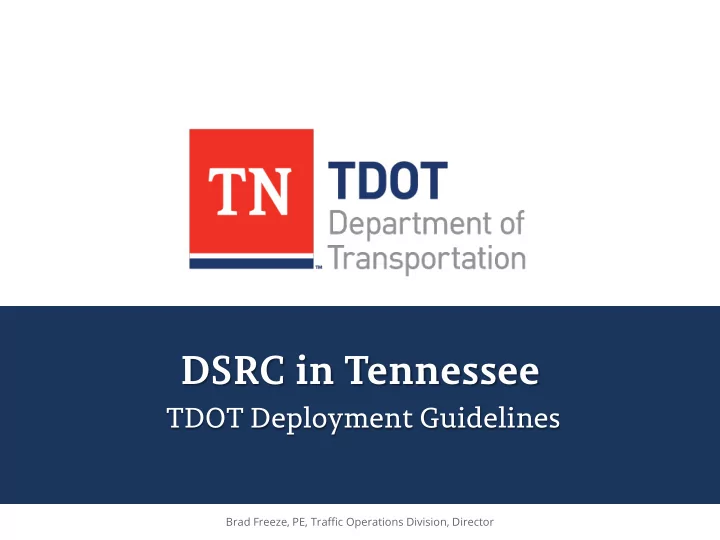

DSRC in Tennessee TDOT Deployment Guidelines Brad Freeze, PE, Traffic Operations Division, Director
Outline Background 1 History 2 Current Activities 3 Next Steps 4
What is DSRC? This? • Defense Supercomputing Resource Center (US DoD) • Dunnings Squash & Racketball Club (UK) • Darnestown Swim & Racquet Club(Maryland) • David Sarnoff Radio Club (a ham radio club) • David Skaggs Research Center (Boulder, CO) • Disability Services Resource Center (Michigan) • Data Software Research Company (Chennai, India) • Duke Surgery Research Central (web application; Duke University; North Carolina)
What is DSRC? Or better yet, this? Dead Serious Rock Concert (for Deadheads only) • Downtown Scooter Reconditioning Center (Lime, Bird, Uber, • Lyft) Dermatologists Sacrificing Rare Carrots (Radical Vegan Skin • Doctors) Detoxified Salad Restaurateurs and Caterers • Disappointing Sauce Reimbursement Center • Difficult Salespeople Recording Conversations • Disco Seventies Retro Car •
What is DSRC? • Dedicated short-range communications are one-way or two-way short-range to medium-range wireless communication channels specifically designed for automotive use and a corresponding set of protocols and standards. – In 2004, the FCC dedicated 75 MHz of bandwidth at 5.9 GHz to be used for vehicle safety and other mobility applications. DSRC operates in this band, and has been developed for over a decade by a range of stakeholders including automakers, electronics manufacturers, state highway departments, and the federal government. – Low Latency & Limited interference: DSRC latency is as low as 0.02 second. DSRC is very robust in terms of radio interference with a range of 1000 meters (3281ft). – The intent of DSRC broadcast of a suite of message sets (SPaT, MAP, BSM, RLW, etc) at 5.9 GHz is to provide secure transmissions of the data with short time delays during all weather conditions
SPaT – Signal Phase and Timing • Common Message Set delivered via DSRC
J 2735 SPaT Message
J 2735 SPaT Message
J 2735 SPaT Message
NTCIP 1202 v03
NTCIP 1202 v03
NTCIP 1202 v03
NTCIP 1202 v03 - Architecture
NTCIP 1202 v03 - Architecture
Current TDOT Activities
DSRC Statewide Guidance – Highlights • Purpose and Intent • Summary of Research • Implementation Guidance • Design Process – Roles and Responsibilities • Design Elements • Integration and Testing • Maintenance and Operation
DSRC Statewide Guidance – Purpose and Intent
DSRC Statewide Guidance - Summary of Research Valuable insight gained from SPaT Challenge partners and other agencies at • various stages of Connected Vehicle deployment. Sample of agencies consulted:
DSRC Statewide Guidance – Implementation SPaT Message Output from • controller Conversion of 1202 SPaT Message • (NTCIP format from controller) to J2735 SPaT Message (SAE format that car can understand) Generation of MAP Message • Generation of GPS Correction • FHWA – JPO -17-589 DSRC RSR • Specification FCC Licensing and Spectrum • Management Existing and New Hardware • Requirements Equipment performance • requirements
DSRC Statewide Guidance – Design Process • Designer – Traffic Engineer; operational use case; intersection geometry; – ITS Network Architecture; coordination with all stakeholders • General Contractor – Integration; message set format; communication paths • TDOT – Set guidance; develop standards; facilitation; FCC license management • Signal Maintaining Agency – Operate and maintain infrastructure; data managment
DSRC Statewide Guidance – Design Elements Road Side Unit (RSU) • Managed Field Ethernet Switch • ATC Controller • Backhaul Communication • On Board Unit (OBU) •
DSRC Statewide Guidance – Integration and Testing
Current TDOT Activities
Next Steps • Training for TDOT staff • Training for signal design community • Lessons Learned from I-24 • Vision for future of DSRC in Tennessee – Partner with local signal agencies who are preparing for V2X technology such as DSRC • Chattanooga • Knoxville • Others
Summary Statewide DSRC Deployment……. ……is a huge undertaking ……must be built on a sustainable foundation of well maintained infrastructure And……. …..We must collaborate in order to be successful – TDOT – Local signal agencies – OEM/Automotive Industry – Academia – Engineering Consultants – Equipment vendors & Contractors
DSRC Costs Estimates Per AASHTO Roadside Equipment and deployment $12K to $18K per intersection Backhaul communications $4K to $40K (existing?) On-going operations and maintenance $2K to 3K per year
Is DSRC the Betamax Version of CV? * Current Advantages of DSRC: 1. It has a well-established standards for the equipment and messages. 2. It has been tested in robust environments for a decade. 3. It has a dedicated spectrum. 4. It communicates messages a very low latencies. 5. Certifications bodies are involved in verifying the performance of devices. 6. There is a large group of experienced agencies and individuals who are sharing best practices. 7. The communications does not require a subscription fee. 8. It is commercially available and in active use. *Provided by Blaine Leonard, P.E., UDOT
How long can we wait for standardized CV? In 2018, researchers at the University of Michigan Transportation • Research Institute completed a study (Sayer, Flannagan, and Leslie, “The Cost in Fatalities, Injuries, and Crashes Associated with Waiting to Deploy Vehicle to Vehicle Communication”) which quantified the cost of delaying deployment of safety-critical applications. Specifically, they evaluated the cumulative number of lives which will be lost if we wait even three to five years for a new technology to be developed and proven. They concluded that tens of thousands of lives can be saved by deploying DSRC now.
Thank You! Contact Information: Brad Freeze, PE | Director Lee Smith, PE | Assistant Director Traffic Operations Division Traffic Operations Division p. 615-741-5017 c. 615-202-1391 p. 615-253-6705 c. 629-221-0867 Phillip.B.Freeze@tn.gov Lee.J.Smith@tn.gov
Recommend
More recommend